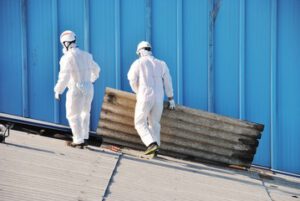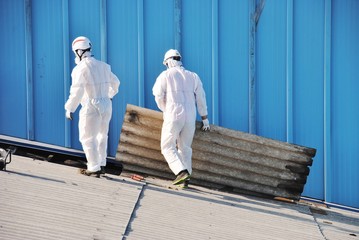Asbestos fibers can damage a person’s health by inhalation. Some of these fibers reach the deepest air passages in the lungs, which are coughed with mucous.
A certified asbestos-abating professional will examine a building before beginning work. They will seal air ducts, turn off HVAC systems, and install negative air pressure equipment. Click https://www.perthasbestosremovalwa.com.au/ to learn more.

Asbestos is a naturally occurring mineral fiber mined from the earth that is extremely heat and chemical resistant. It is also very light weight and odorless. These properties led to its use in more than 3,000 different construction materials and manufactured products. It was used in insulation, ceiling tiles, shingles, furnace and boiler pipe wrap, asbestos cement and more. Even today, homeowners are still finding asbestos in their homes.
The only way to know if something contains asbestos is to have it sampled. It is recommended that you hire a certified asbestos inspector to perform a sampling or inspection. Companies that can do this work can be found on the MDH’s Find A Contractor or Consultant web page or by calling MDH.
An asbestos inspector can check for a material’s asbestos markings and can collect samples of the suspected material for testing. They will patch the area where they are collecting the samples so that no fibers can be released and then send the material to an accredited lab for testing. If the results show that the material does contain asbestos, the inspector will inform you of your options for addressing the problem.
It is important to note that asbestos only poses a threat when it is disturbed and its microscopic fibers are released into the air. If the fibers are inhaled or ingested, they can cause serious health issues, including lung cancer and mesothelioma.
Slightly damaged asbestos-containing materials should be left alone. However, if the material is damaged or you plan to make changes in your home that could disturb it, you should get it repaired or removed by a professional.
Any non-friable asbestos material that is not in need of repair or removal should be labeled as such and stored in a secure place until disposal. This includes category II non-friable asbestos containing materials (anything that doesn’t crumble or become pulverized when handled) such as transite wall and roof shingles, asbestos floor tile and cement pipe.
The person performing the work on asbestos-containing materials must communicate to other employers on the job site, and to workers who may be exposed to those materials, that the areas requiring abatement have been identified as regulated areas. This communication must be done prior to the start of work and at least once per shift.
Asbestos abatement is a hazardous process and requires specialized training. It should only be performed by a licensed asbestos professional, like Precision Environmental. When you’ve hired a contractor to perform asbestos abatement, they will start by performing an inspection and taking samples. Then, they will make a plan for what needs to be done and where it needs to be done. Before beginning the work, your contractors will need to help you evacuate all occupants from the area so they can safely and efficiently carry out the plan. They will also clearly mark all infected areas so that they can avoid contaminating clean areas.
When asbestos fibers are airborne, they can easily be inhaled and cause mesothelioma, a deadly form of cancer that affects the lungs. The latency period for this disease can be up to 50 years after initial exposure. Once the asbestos is inhaled, it can spread to other parts of the body through the lymphatic system and lead to multiple complications.
Before the abatement begins, professionals will shut off your building’s HVAC systems to prevent dirty air from circulating throughout your facility. They will also use plastic sheeting to create a work area that is sealed off from occupied or non-abatement areas. Workers will wear personal protective equipment, such as face masks and respirators, to protect themselves from exposure to the toxic asbestos. They will also set up a decontamination area adjacent to the work area, with a shower for exiting the work zone.
To protect employees and occupants of your property, all workers will also wear quality coveralls that are less likely to tear and expose the hazardous fibers. Additionally, the abatement area will be surrounded by a negative pressure unit to minimize the risk of asbestos particles being dispersed outside the work area. The contractor will also post warning signs around the work site to alert other people that a hazardous asbestos project is underway.
Once the abatement work is complete, a qualified professional will perform another inspection to ensure that no asbestos remains in the air. This includes using a technique called polarized light microscopy to locate microscopic asbestos particles that are too small for the naked eye. They will also take air samples to make sure that the asbestos is gone.
Asbestos is a group of naturally occurring minerals that are comprised of bundles of long and thin fibers. These minerals are found in soil and rocks and have been used in thousands of commercial products for their physical properties, including high tensile strength, flexibility, resistance to heat and chemicals, and electrical insulation. Prior to the 1980s, asbestos was commonly used in a wide variety of building and construction materials, such as roofing shingles, floor and ceiling tiles, wallboard, cement, automobile brake and clutch parts, and textiles.
The most dangerous part of asbestos is when the fibers break down and become airborne. When they are inhaled, the tiny fibers bypass the body’s natural defenses and can travel deep into lung tissue where they can remain lodged for years. These fibers can also cause numerous health problems, such as lung cancer, mesothelioma (cancer of the lining of the lungs and abdominal cavity), and asbestosis.
Exposure to asbestos is usually caused by disturbance of the material, such as during a building repair, renovation or demolition project, or by improper disposal. When asbestos-containing material is disturbed, airborne particles and fibers are released.
Once in the air, the fibers can be inhaled by anyone within close proximity of the work site. These particles can also spread to other areas of the building or even throughout a neighborhood. This is why it’s important to hire qualified professionals for all asbestos abatement projects.
There are many reputable asbestos professionals, and most are licensed and accredited. Before hiring one, check their credentials carefully and ask for references from previous clients. It is also helpful to check their website for testimonials, as these can provide a good indication of the quality of their work.
Once the asbestos abatement is complete, all clean-up supplies and debris should be bagged in asbestos waste disposal bags and double-bagged before placing in a marked trash container for proper disposal at a certified facility. Asbestos cannot be placed in regular landfills, but must be shipped to a special hazardous waste facility. SafeWork NSW has produced a series of videos to help keep tradies and home renovators safe when working with asbestos.
Asbestos abatement can help protect people from dangerous asbestos fibers. However, if any materials with asbestos remain on a property after an abatement project is complete, the asbestos must be monitored and managed appropriately over time. In some cases, the presence of certain ACMs may change over time due to deterioration or other factors. An industrial hygiene firm can evaluate the risks associated with particular ACMs and recommend monitoring and management strategies.
Because of the health risks associated with asbestos exposure, strict regulations exist for how to handle and dispose of asbestos. Licensed asbestos abatement professionals understand these laws and follow them correctly. Any unauthorized handling or disposal of asbestos can put workers and the general public at risk of developing mesothelioma cancer, lung cancer, or asbestosis.
During an abatement project, specialized work clothing and respirators are used to protect workers. All materials that contain asbestos must be wetted before they are double bagged in 6-millimeter plastic bags and placed inside a container that is sealed. The bags and containers are then disposed of in special waste management sites that are designed to safely house asbestos waste. Workers also use wet wipes to clean contaminated surfaces and use HEPA vacuuming to control the spread of asbestos during the project.
An important part of the abatement process is clearly demarcating the work area and informing all building occupants that they must not enter the hazardous area until the project is finished and the results of clearance testing are published. A regulated work area is established by sealing air ducts, disabling HVAC systems, and covering any areas not involved in the abatement process with thick plastic sheets. An industrial hygiene firm oversees the work site and ensures that all protocols are followed.
Even though the use of asbestos was banned in 2005, a large portion of buildings still contain this toxic material. Any building with asbestos that requires repairs or renovations must undergo asbestos abatement. This will prevent the spread of harmful asbestos fibers and protect residents. In addition, since mesothelioma specialists have not found a cure, it is crucial to take action immediately to reduce the risk of asbestos-related diseases.

